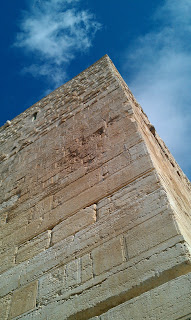This afternoon I had the privilege of walking through one of the newest tunnels being excavated in Jerusalem. It is a tunnel that runs from the west side of the City of David to the base of the temple, following along the temple's western wall. It has been open a little less than a month and is supposedly going to continue being dug through over the next few years. It seems, as of now, that it was used in antiquity as a water channel. Anyway, I mention that here because once I came up out of the ground, I was standing beside the western wall. Walking south a number of yards to the corner of the western and southern walls, I saw a very significant place, which in Greek is called το πτερυγιον (the edge, pinnacle or summit).
Below, you can see a photo that I took of το πτερυγιον. This is the place where, according to Matthew's account, Jesus likely was tempted by ο διαβολος (the devil). Here's what Matthew's account says in Greek, followed by my translation and then a photo I took today:
"Τοτε παραλαμβανει αυτον ο διαβολος εις την αγιαν πολιν και εστησεν αυτον επι το πτερυγιον του ιερου"
"Then the devil took him to the holy city and he stood upon the highest edge of the temple"
The are several important things that could be said about this highest edge of the temple, particularly in the time of Jesus. One, the most obvious perhaps, is that it is a place from which one can see everything around it; it is a bird's eye view of sorts. Here, for example, is what Jesus may have seen (click images to make them larger):
Two, it is the place where, again, in Jesus' day, a trumpeter would announce the beginning and end of the Sabbath by playing the trumpet. It is this second detail that is typically lost on readers of the Bible. A recent archaeological find containing a Hebrew inscription which reads "to the place of trumpeting to" (which you can see just below) marks the southwest corner and pinnacle of the temple. Here are a couple of images:
(This is the bottom of the inscription seen in the picture just before it. The lip or edge here denotes the place where the trumpeter would have stood and possibly, where Jesus may have stood as well.)
The significance of this in one regard is that it functions to heighten the drama of Jesus' temptation story even more! In the story recorded in Mt 5, Jesus is not simply standing in a place where he can see the city below him, he is also standing in a place that marks the beginning and ending of the Sabbath, the place from where God's Israel is called to rest in him. In Matthew's story, Jesus announces from the highest edge "It is also written, 'Do not put the Lord your God to the test.'" The trumpeting call of Jesus is faithful obedience to God, an obedience that is not testing God or manipulating him but rather, trusting in him. Could it also be suggestive of Jesus being Lord of/over the Sabbath? Perhaps I am reaching here but these are just some initial thoughts I've had and I thought they'd be fun to share. Certainly, there is much more to say but that's all for me from now. What say ye?





No comments:
Post a Comment